The unexpected inspiration of Ralph Lauren womenswear
Something that I find often surprises readers is how much the brands they admire are influenced by womenswear.
It’s a topic we discussed briefly with Saman Amel last year, with Dag and Saman talking about old collections that inspired them, my personal favourite being Margiela at Hermes (below).
While consumers can often be quite narrow in their tastes, designers tend to cast a wider net, whether it’s womenswear, big-brand fashion or architecture.
Personally, I think consumers should look more broadly too.
When you start on your sartorial journey, there is an understandable desire to copy - to lift whole outfits.
But as your eye matures, it becomes easier (and more rewarding) to see smaller points of inspiration elsewhere, even if it’s just a use of proportion, or colour.
This was reinforced for me when reading the history of Ralph Lauren womenswear recently. I was really struck by how much more inspiring, in terms of new ideas, the women’s collections were.
The Safari collection from 1984, for example (above). While it features men too, it's dominated by the white, khaki and rich-brown combinations of the women.
Looking through those images made me want to go away and put together summer combinations of linen, khaki cotton and brown leather. Perhaps an olive-green jacket.
It helps that the clothes are so clearly influenced by Ralph’s menswear, of course. But even the women’s white dresses and floppy sun hats make me think how well white linen and straw go together.
I suddenly wish I had more summer trousers with belt loops. A dark-brown belt looks like a really useful way to divide a shirt and trousers both in light colours - indeed, in some looks, in the same colour.
Certainly, some of these combinations would be more at home at Pitti than my local high street. I’m not going to wear a cream-linen suit, white-linen shirt, and butter-coloured straw hat at the bus stop.
But I could wear that white shirt with tailored mushroom-brown trousers and polished chocolate loafers. (Or, to push the boat out, mushroom-brown shirt and white trousers.) And I wouldn’t have been inspired to do so if I hadn’t looked at these images.
Ralph’s first collection for women was basically a straight copy of the menswear, just with different proportions and details.
The polo coat was longer, waisted, and had little pleats on the pockets (above). The male-inspired shirts were apparently popular.
But he quickly realised that women’s fashion was different, and if he wanted to be noticed for more than a single season, needed to offer something at least a little different.
It was that search which led to collections such as Safari, and most famously, the Western collection in 1978 (below).
That was probably the most influential of all the campaigns, for its immediate impact and because it was the first.
There’s less that I find directly inspiring there, although it does spur thoughts and denim and rough-out suede that will mature later with RRL.
The 1981 Santa Fe collection, however, is a different story.
Anyone that likes tweed, or Fair Isle patterns, will find something in these colour mixes - the combination of maroon, grey and turquoise, often with a soft white or chambray shirt underneath.
And of course this was the first mainstream exposure to south-western jewellery, which has become popular again recently.
There were then two stand-out collections inspired by traditionalism - Fall 1982 (below) and Fall 1984 (further down).
The first was all tweed and velvet, patchwork and paisley. Lots for the menswear enthusiast to dig their teeth into.
Ralph said at the time: “Everyone else was blasting the music and showing a lot of flash, and I did this chic, quiet stuff with lace and antique suits and hand-knit sweaters.”
Bernadine Morris of the New York Times described the look well: “The clothes looked exceedingly well-bred, and though they were nonassertive, they make a powerful statement.” I love the line further down that same piece: “It offers a quiet excitement, without reaching into the bizarre.”
On a personal level, it makes me wonder whether there's any way I could wear tweed and velvet together.
Fall 1984 was the English thoroughbred collection. Shot in an English manor house, it was full of walking boots, chalkstripes and flannel.
In Alan Flusser’s words, it reflected Lauren’s appreciation for “aristocratic taste and the muted elegance and genteel refusal of ostentation that are its hallmarks”.
Although there are again men in the campaign, it’s the women that stay with you. The shot of the outdoor art session (first image below) is gorgeous: brushed cotton shirt under tweed jacket, with tweed coat draped on top. And paisley skirt.
It makes you want to bury yourself in sombre, muddy colours. To never wear anything with any contrast again.
The Diana-like shot of navy chalkstripe suit and buttoned white shirt is equally inspiring, and in a very practical way. I have a navy flannel suit, white shirt and black shoes. I can wear that look - I’d just forgotten how good it could be.
By contrast the most famous image from the campaign - wing-collar with black tie and fur-trimmed robe - is pure fantasy. With no practical application unless you live in such a country house, and give a lot of parties.
By the way, if you want further inspiration, Fall 1994, 10 years later, is also worth a look.
Finally, there's a little coda about women’s style that’s worth mentioning.
A central theme of Ralph Lauren womenswear has been mixing clothes in unexpected combinations. A cocktail dress with a vintage leather jacket; a battered plaid shirt over a pinstripe suit. Indeed, Flusser sees it as a particularly American form of dress.
This is what we sometimes refer to as high/low dressing. And while it's much easier to do with the freedom of womenswear, it does have the potential to make both men and women look more spontaneous and more personal.
Ralph, via Flusser, has some tips in the book on pulling it off. First is that it helps if the pieces are ‘stand-alone classics’. Not a tan pinstripe suit, but a navy one. This lessens the risk of overkill.
And second, the aim is unexpected weights or textures, rather than colour or pattern. The leather jacket appeals over the cocktail dress because we can almost feel the difference in texture.
I’m still not convinced Ralph’s signature look of tuxedo with blue jeans really works. But at least I know what he’s getting at.


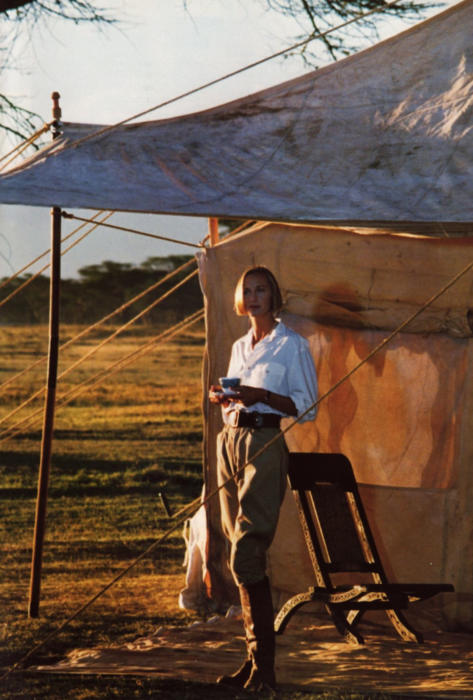
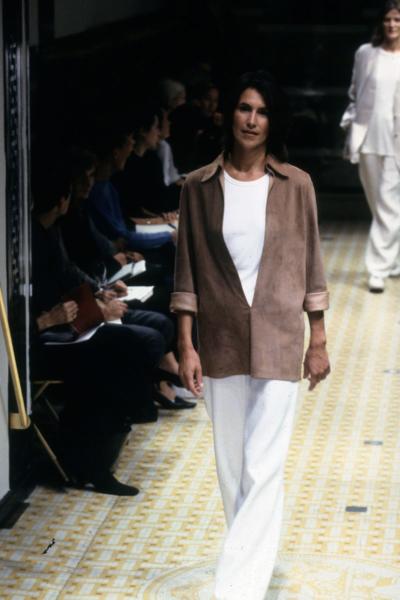
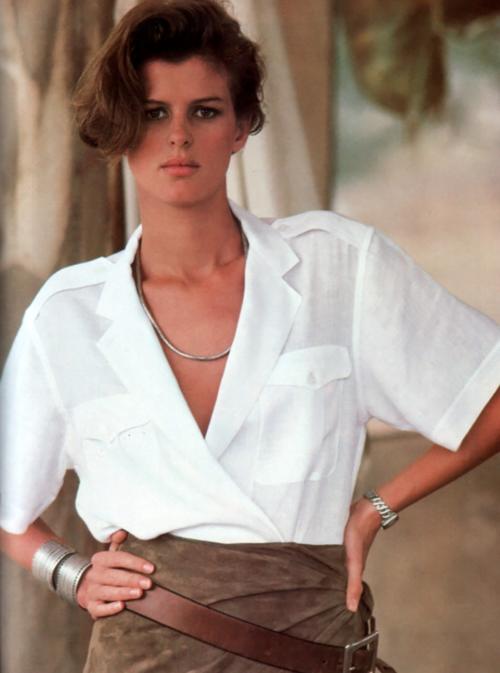
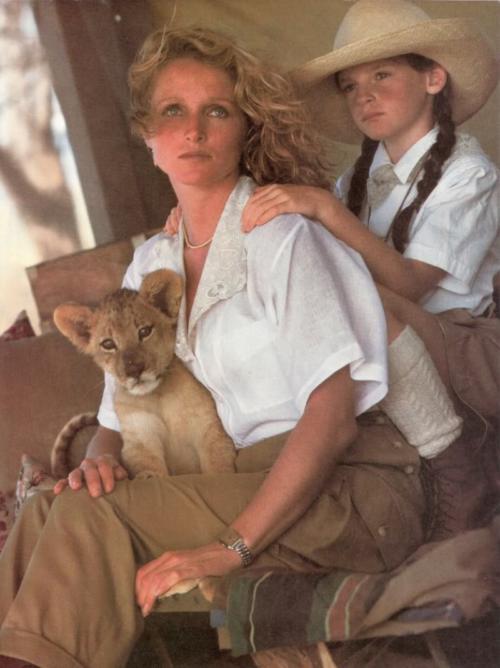
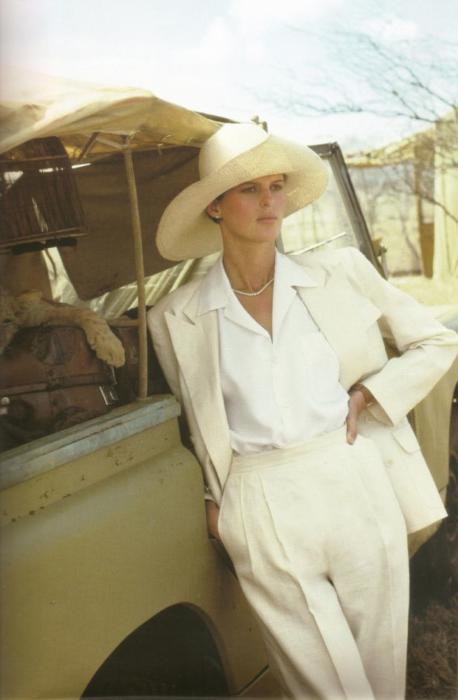
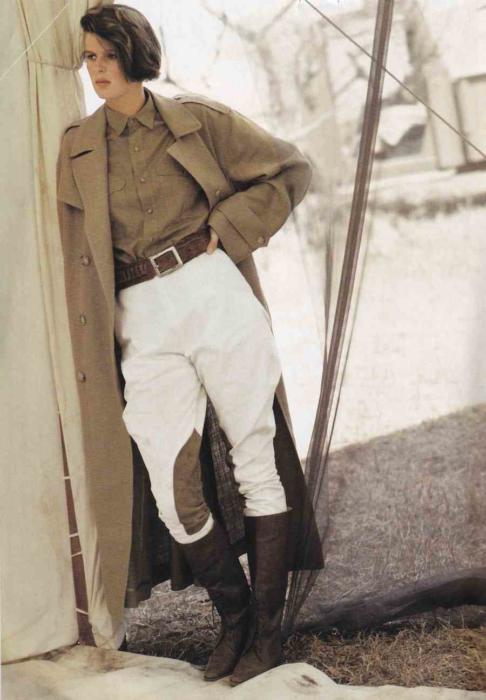
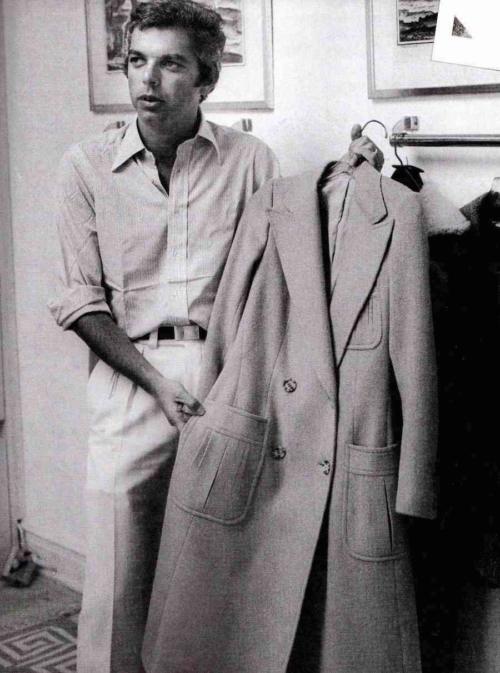
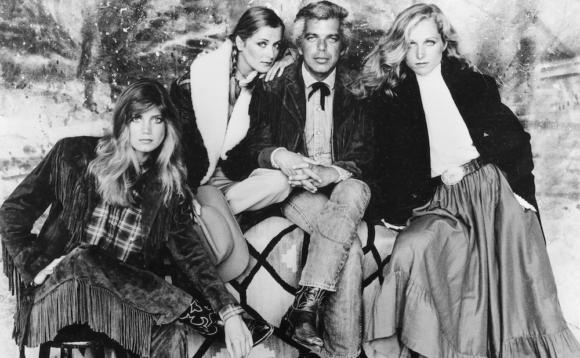
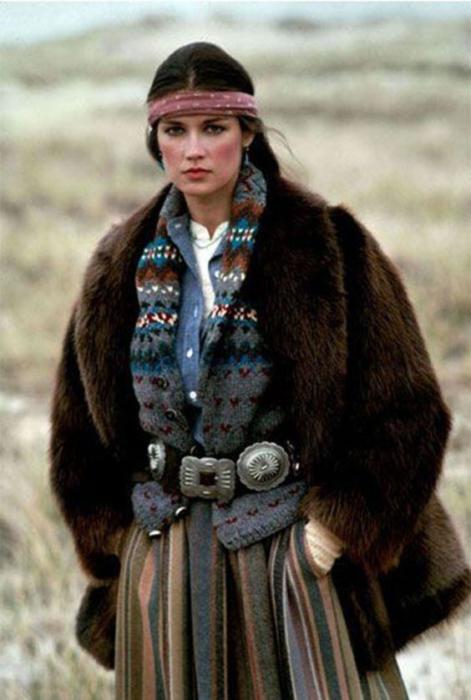
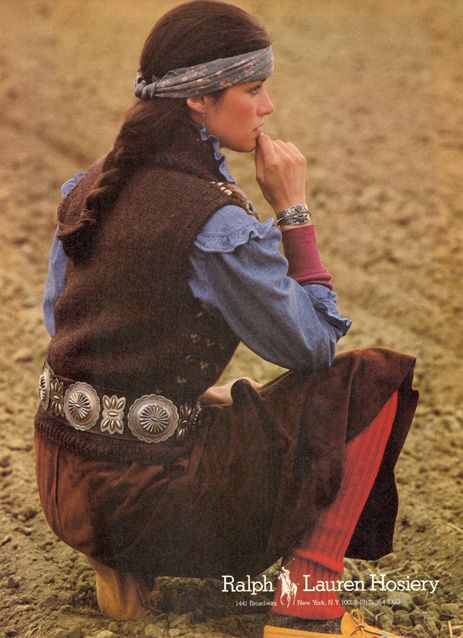
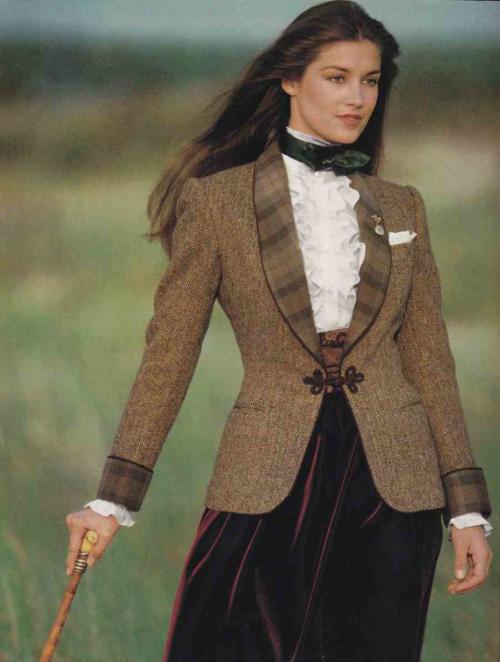
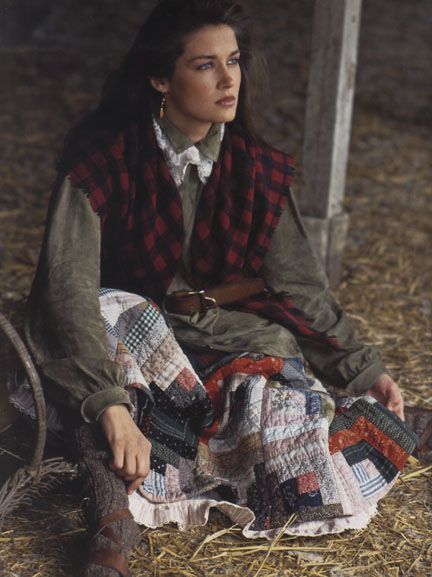
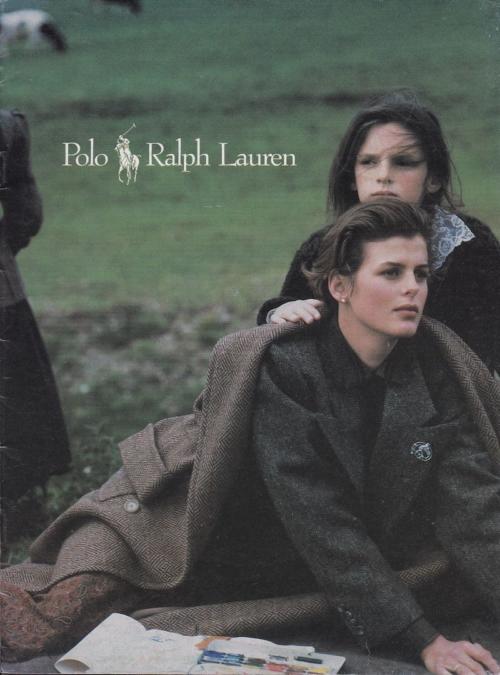
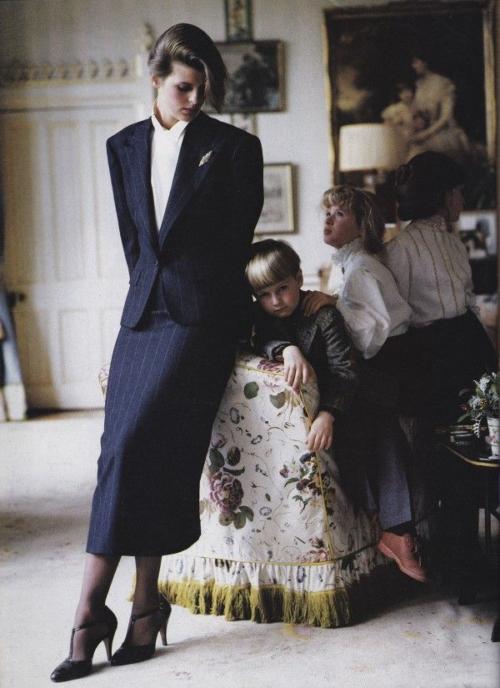
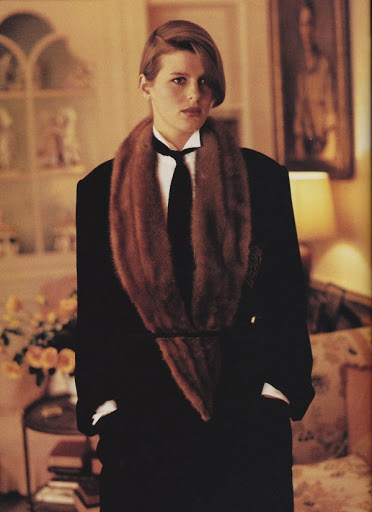
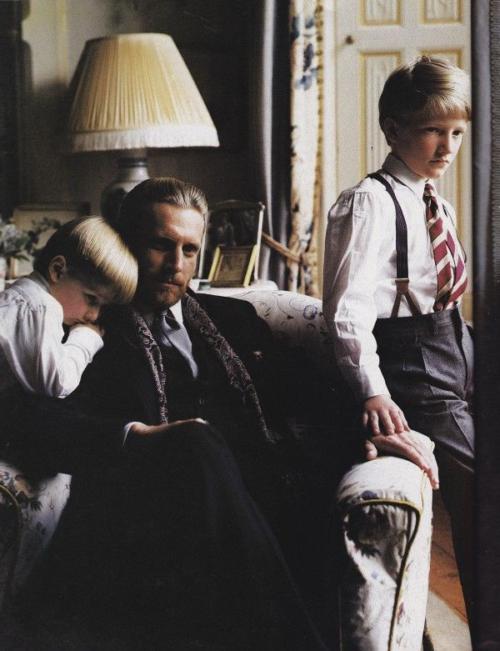
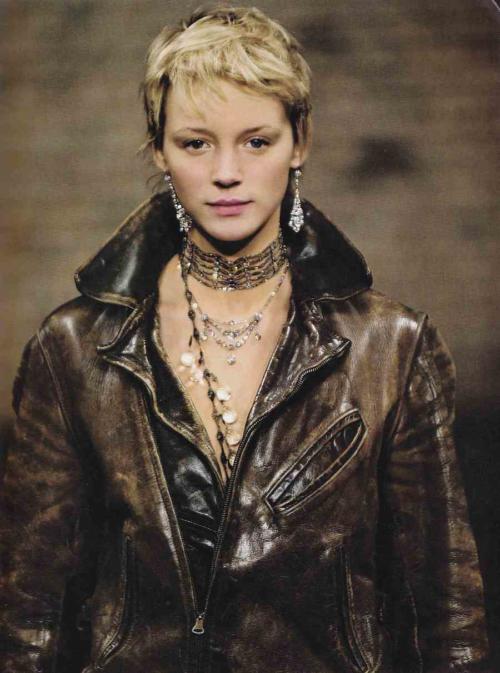


























very fun piece. You mention “the freedom of womenswear” – I find it interesting just how true and deeply ingrained that is, but rather under-interrogated. The other day my wife was looking at some jackets online from a brand called Blaze Milano. Their look book shows a double breasted navy blazer with worn-in jeans, white t shirt, trainers – and it looks fantastic. But it would be next to impossible for a guy to make that work. Why is that? Blokes wear jeans, tennis shoes, and white t shirts too, so why does the inclusion of a blazer cause such instant chaos for men, and (often) such immediate elegance for women? It doesn’t seem to make rational sense. The multi-layered mysteries of the hyper subtle art of communication through clothing…
I think one part of it is that it’s more socially acceptable for women to be seen to be making an effort. To wear an outfit that is clearly much-considered, mannered, and driven by a fashion. Perhaps a harder question to answer is why that is seen more positively.
I also think men sometimes underestimate how much women (in general) have thought about and read about clothes their whole lives. When I talk to female friends, they all have the kind of things we talk about ingrained in them. Like the fact that blazer with jeans might be very soft shouldered – and therefore looks good in the combination. Or, if it were very strong-shouldered, how much more striking a look it would be.
These things exist at the level of just looking wrong, or just looking right – which comes with time. Perhaps a little like language. In my native language, I don’t know the rules. But I need to learn them in another one.
great thoughts – thanks Simon
As always, some interesting insights. On the question of ‘surprise’ combinations I’ve (fairly) recently been surprised by some serendipitous pairings I’ve come across when packing to go on holiday. You put the items out, having a good idea of what you propose to wear with what, but then as part of the packing process you see together items you’d never have thought of combining, et voila! Of course you don’t (and can’t, currently) have to be going on holiday to get stuff out and try new combinations.
Massimo Alba makes some relaxed velvet chinos in muted tones that I wear regularly with tweed jackets. I don’t think it looks foppish. They come across as a variation on cords. I hope.
Ooo. I still don’t think it would work (on me) but I will now have a look.
Reading this blog piece and reading the comments below reminded me of something I too have wondered about and drawn some conclusions about. There are a couple of reasons why men’s clothes reflect far less in the way of inventive and novel cut, colour or material/texture combinations.
The first reason is a rule-bound rigidity. We have so many tightly defined rules about what is appropriate and manly, and what is not, that change in any direction is seen as breaking the rules and therefore being unmanly, loud, foppish or simply ludicrous. Men are extremely resistant to clothing style changes in most Western cultures, although not in some Eastern cultures. In my old country, India, the classic Western suit and the classic Indian suit (closed collar, tunic style short jacket and trousers) have both been experimented with in a variety of ways, changing lapel structure, the presence or absence of lapels, pockets and pocket stance and placement, button stance and number, material, color and texture variations, etc. Granted much of this variety is displayed by those in the music, film and show businesses. But the experimentation is there. In the West, the variations, all of them cyclical, have to do with details that are minute, by comparison. Lapel width, placement of gorge, darts, flaps on pockets, pleats, cuffs — that’s about it. So a willingness to experiment is seen as something that breaks what is de rigueur. Perhaps this has to do with a belief that rectitude and integrity can only be reflected by clothes that are dark and sober, with little in the way of flourishes other than patterned and coloured neckwear.
The second reason is personal comfort and a kind of uncomfortable self-consciousness with anything that deviates from prescribed rules and practices. Wearing red as a colour is very unusual, unless it is part of a prescribed military uniform. Red sportcoats are very unusual, and I have never seen an image of a man wearing a red suit. Maroon is a bit more common, although maroon suits are still unusual. But red somehow is beyond the pale as a colour for most men, unless you are a member of the military or royalty (who wear military uniforms, often with red jackets). Maybe bright colours and patterns are seen as unserious, and perhaps this view itself may be related to how historically, men have viewed women as second-class citizens, lacking seriousness of purpose and all the rest of it.
Neither of these reasons seem to apply to women. Their clothes are far bolder in innovation and design, they are open to a far broader range of colours, and they appear to be less self-conscious in wearing different cuts or colours. To use my earlier example with the colour red, women often appear wearing red jackets and suits, and they would be perfectly fine doing so in a fairly formal setting. In fact, formal attire is a good example of the things I have been talking about. The men are uniformly dressed in two colours, black and white, with only slight variations here and there, in a tie or cummerbund. Regardez les femmes: They wear a huge range of colours and styles in their evening clothes, and it is even acceptable and very sexy for a woman to wear a man’s tuxedo, albeit cut in feminine proportions.
So perhaps a deeper question to ponder might be why men and men’s stylists and clothiers are so hide-bound when it comes to innovation in clothing. Even writers on men’s style pride themselves on the unchanging nature of male clothing, like the suit. Why?
As in all rules and generalizations, there are always striking exceptions. On runways showing male fashions in recent years, something that would startle most men has made its appearance, something that contravenes all the rules: Skirts for men! And yet, consider: In the centuries past, men wore clothing that looks to me remarkably like skirts and dresses! Their structure is very similar to that of women’s clothes, save for some insignia or feature that announces manliness, like a belt with a scabbard and sword. There are also cultures in the world where men and women wear sarongs, mundus, salwars and other items of clothing that are more or less the same for men and women.
In the animal kingdom, we are the exception. Males in most other species are more resplendent than the females.
Very interesting points, thank you.
To be honest, I don’t think many men I know want to stand out like that. I don’t know whether it’s because of gender, or society, or what mix, but it’s not the designers that are letting the men down – most men just don’t want to buy things that are more demonstrative and excessive.
Of course, that might be a result of what is presented to them as well, but I do think most would aspire to being elegant, to be considered well dressed, and of course to being good looking. But not much more than that.
Also, on colour, just to point out – there is no lack of it in Ivy or Preppy traditions in the US, or country attire in the UK. Red trousers, yellow socks, pink shirts and green ties.
There’s freedom in not being tossed about by the winds of fashion. While women do enjoy talking about and experimenting with different looks, they also find it exhausting, Women also like men who dress in a traditional manner. Ask a woman what man she’d rather have dinner with; the man in the navy suit or the man in the red suit.
Very true
I remember having an interesting conversation about this topic with my wife several years ago – about how women have such a much greater of styles and colors to choose from compared to men.
The primary reason for this “rigidity,” I think is that most men do not want to “stand out like that” (to quote Simon). At least that’s true of Western men. Several reasons come to mind.
First, at least to a certain degree, men tend to wear what they think women will find attractive. And most women are attracted to men who take some care – but not too much care – about their personal appearance. In other words, they tend to like men who are, at the very least, put together well and not slovenly; on the other hand, most women are not attracted to men who obsess over their personal appearance. Most women do not want to be with a man who takes as long or longer to get ready for an event than they do. Of course I’m generalizing here, but outside the art world, it’s generally socially acceptable – and expected – for women to put more of an effort in their personal appearance than men.
You can see this convention play out at elegant events. When a couple goes out to an event together to a wedding, ball, soiree, cocktail party, opera, etc., the convention is for the woman to be the star of the show and for her escort to be her elegant foil. Hence at most formal events, men are expected to dress wearing dark colors, while women (particularly younger women) can wear very brightly colored outfits that can be easily spotted across the room. Hence if a man were to wear a red tuxedo, he would succeed in standing out but not in a good way, whereas it is perfectly fine for a young lady to wear a bright red dress. (Age is also an interesting consideration – generally speaking, a woman in her 50s will dress less “loudly” in terms of color choice and cut than a woman in her 20s).
Second, to the extent that men dress for other men, the primary goal is to be taken seriously. Most men do not want to be seen by other men as obsessing over their personal appearances. This is especially something that is true in the professions. A lawyer who dresses like a popinjay will not be taken seriously by either his clients or his fellow lawyers. In fact, I’ve noticed that these expectations can also affect female attire. Generally speaking, female attorneys and doctors and bankers dress in darker colors, more conservative cuts, and tend not to use nail polish as often ladies in other fields because they do not want to come across as frivolous.
This helps explain the obvious exception to these rules -i.e., men who straddle the art / movie / music world. Men in these careers want to look creative; their primary concern is not being “taken seriously”; if anything, the expectation is that they should subvert rather than adhere to convention. Hence all the wild outfits that many artists and actors wear.
Excellent points, R Abbott. I think you have summarized the basis of male and female dressing and the purposes behind them very well.
That was an interesting read Dr Peter – Thanks!
You’re very welcome, James. And thank you for the kind words.
RL’s stuff all looks a bit contrived to me.
Even given it’s a fashion ad Thorn? Fashion looks will always be contrived – or in their words, aspirational. No one would ever wear the whole look.
The intention is more to give a bunch of ideas from which you might take one, certainly with menswear. It might be as simple as two that are nice together.
I suspect RL’s classic “aspirational” marketing strategy is no longer very effective. It’s now the popular/social/print media rather than the brands that control imagery, and aspirations are increasingly of the hypebeast variety. RL stuff, consequently, increasingly (and correctly) seems contrived. Not to say that the company isn’t changing with the times: their recent annual revenues look just fine.
You’re right, they certainly don’t have the power they used to, and perhaps those looks do look more contrived as a result.
Although streetwear brands often look no less contrived in their imagery, almost by struggling so hard to look natural.
Of course streetwear brands still engage in RLesque world-building-cum-brand-construction and make silly lookbooks. It’s just no longer the primary factor behind either of their success, to the extent that they succeed. Hypebeasts don’t push a coherent aesthetic; they mostly just get behind existing hype.
RL was on slippery ground in the mid- 90s when their ads depicted models striding out to the pitch, decked in cricketing flannels, wielding the willows and wearing batting pads and gloves but ( wait for it) in oxfords!!!
Haha, RL probably never talked to actual cricket players! Having played for my school and university, I could have set the old boy straight about cricket boots.
Contrived or, typically for PRL, copied from elsewhere. “Out of Africa” was being filmed and/or finished in 1984. The safari look above is very Karen Blixen as played by Meryl Streep. Coincidence? I think not!
Interesting Kenny. Do you have anything on that beyond assuming it’s not a coincidence?
I don’t think there is anything to learn here other than the fact that Ralph is a great merchandiser. Sometimes a merchandiser of shoddy goods but a great merchandiser nonetheless.
Personally I think that Yves Saint Laurent and Giorgio Armani have both been much more creative and influential in taking styling cues from womenswear and incorporating them into menswear.
The longstanding catch 22 for selling menswear is that men are inherently more conservative and trends move slowly. There is a shortage of men who want to dress as American Indians.
Wonderful conversation, gentlemen !
Simon -as ever a provocative post
Velvet and tweed -hell yeah !
But in reality doeskin waistcoat and a tweed hacking jacket seems more possible and perhaps even traditional?
Do you think moleskin trousers and a tweed coat achieve the same contrast?
I don’t think so unfortunately James. It would be the same idea, certainly, but without the degree of contrast that’s really the attraction of contrasting those two materials, for me.
A silk scarf around the neck of the tweed jacket might be closer.
Dr Peter’s pointed comments remain, though. Men weren’t more conservative in the seventeenth century, and in our own plenty of them love showing off and standing out: their fast cars and stylish gadgets, how much money they have, their trophy wives, how much they know, and whom. Clothes seem rather the exception, don’t they? Men’s clothes, that is, for as Anne Hollander points out, women are largely dressed by male designers (Sex and Suits).
Me Tarzan …
Simon – this is by my estimation the second time you’ve put Ralph Lauren on your site so clearly must have had some influence. Have you thought about reviewing his suits and compared them to them to the Saville Row suits he was trying to imitate?
Hey Kali,
Nice point, and yes it would be a nice addition to the increased made-to-measure we’ll have on the site over the next few months.
Cheers
The late 60s and early 70s were something of a golden period in menswear insomuch that we were presented with real choice even if much of that choice was execrable. There were opportunities to experiment and develop a personal style that would later be ‘taken back’ to more traditional menswear. One could thus wear ‘the uniform’ if one wished but with a personal twist that would be recognised by others of your tribe.
For most of my twenties I lamented the general lack of choice in menswear compared with womenswear and had to work hard to dress in a way that allowed individuality without rocking the boat unnecessarily.
Someone who understood this was the late Jonathan Silver. His menswear from the 70s had edge but often demanded a second look, such as when he sold a range of label badges or brooches for men, one of which declared “wanker”.
He once pigeonholed me and demanded to know where I bought leather laces for what were a pair of perfectly ‘normal’ Church’s brogues. He is sadly missed.
My apologies: I had of course meant to say buttonholed not pigeonholed. Not sure if it was a senior moment or Freudian slip.
The photographs are beyond aspirational – they are works of art in their own way. Obviously people would only dress like that in RL’s alternate universe, but what a lovely universe it is to dream about!
Indeed, these photographs captures and carries a certain depth in their composition and ages with a certain patina from almost thirty years ago similar to many of Ken Burns’ documentary work, it projects a melancholic hope and goodness that we all wish and want to believe in.
There is freedom in simplicity. The two style icons that personify this concept are the late, great Steve McQueen and Daniel Craig. Simple ensembles of either dress or casual wear that fit well and of good quality are the hallmarks of the well dressed, confident man. McQueen never dressed like a popinjay and Mr. Craig doesn’t either. Another component of both these men is physical condition, always in shape. Being fit will always help a man look better in his clothes.
A bit of an odd question but perhaps not too odd considering this article does try to nudge along the borders of respectable gentlemen style. What do you think about Lazy Mans, specifically the brogued variety? I’m curious about your thoughts in this regard and seems like you may not have touched upon the topic.
As in, the shoe style, with a pretend lacing at the front and elastic instead on the sides?
I think it’s a harmless little pretence. Not silly enough to be called a gimmick, but also something I can understand the very classically minded rejecting for being a little silly.
Personally I’ve never been that attracted by them, brogued or not, but if I wore black oxfords every day I can see them being a nice alternative.
Yes, exactly that. I’ve been in two minds about getting one. Some people seem to find them really tacky and yet they seem like an interesting innovation. Glad to hear your opinion. Would the Saint Crispin and Cleverley models be a good place to start exploring?
Yes, absolutely
Thank you for this article. RL’s 1980’s campaigns were masterpieces. Such eye candy! Pure fantasy and glamour without a hint of either vulgar or bizarre. And those models were stunning.
These women are stylish and haven’t got the waif appearance which makes them more real.
My eyes were drawn to the color combinations and apparent quality of their wardrobe. Color and quality.
As to South Western jewelry, the belt w/ silver. That goes back to the ’60’s hippy movement long before Ralph. See Jim Morrison of the Doors in leather trousers and belt w/South Western silver adornment in the mid ’60’s.
This is a very interesting topic indeed. One thing I always find is how much more luxurious fabrics look on women. Naturally a silk blouse looks nicer than a cotton mens shirt, but even with stuff like linen trousers, they just seem more luxe on women. Something I credit a lot to more dramatic cut, focusing on drape and flow.
Another is how (seemingly) freely women can move between styles. From one day to the next they can go from classic dress like pant suit or skirt and jacket, to jeans, loafers and untucked oxford shirt the next, sneakers, jeans and a cardigan, dress, leather jacket, pin stripe suit, all accompanied with dramatic and striking overcoats etc.
Whereas if a man would do that, he would be seemingly schizophrenic and lost, at least that’s how it seems. The most obvious exception to this rule would be Alessandro Squarzi in my mind.
The fact they can and do this is surely also why fast fashion brands like H&M and Zara are so successful, since the closet is ever changing. An old discussion with my wife comes to mind. She couldn’t find a coat she liked so I tried to convince her to go mtm or bespoke for a really great one. Something she said she’d never to as she grows tired of the coats after one or two seasons.
It’s very much the same challenge as you mentioned when writing about the womens line from B&L, Simon. The quality difference is obvious, but convincing women to pay that much for ballet flats is a whole other thing.
I highly recommend the book “Margiela. the Hermes Years”! The described functionality and the thoughts behind the clothes (multi-purpose of the clothes; hidden pockets; etc.) are unmatched – I think even compared to the more function-oriented menswear.
If you only want to see the runway pictures (also very inspiring), you can google it. At Vogue there are pictures of some collections.
Great recommendation. Thanks Jeldrik